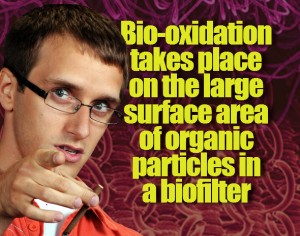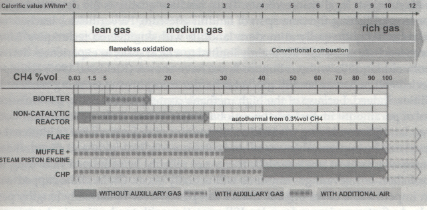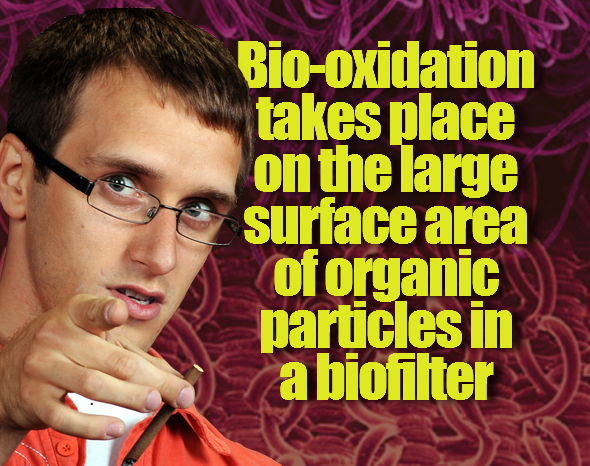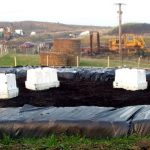The Landfill Gas Biofilter – Developing Bio-oxidation Filter Technology for Landfill Gas Treatment During the Long Period of Dwindling Gas Yields at Modern Sanitary Landfills
(This article is based upon a paper ref: M. Huber-Humer; Dwindling Landfill Gas – Relevance and Aftercare Approaches; 2nd Boku Waste Conference 2007, Institute of Waste Management, BOKU.)
The production and composition of landfill gas varies in time, but the primary trend is always toward a decrease in methane content and a progressive reduction in the total amount of landfill methane produced in the long term.
 The time-dependent behaviour of gas generation is affected by several factors and processes, such as meteorological conditions (e.g., temperature, precipitation, barometric pressure), waste properties (e.g., amount of biodegradable organic matter, water content), top cover design (permeable or tight), and kind of landfill operation and management. The latter all produce a strong impact on chemical and biological processes occurring in the landfill during the degradation of organic compounds, leading to gas generation.
The time-dependent behaviour of gas generation is affected by several factors and processes, such as meteorological conditions (e.g., temperature, precipitation, barometric pressure), waste properties (e.g., amount of biodegradable organic matter, water content), top cover design (permeable or tight), and kind of landfill operation and management. The latter all produce a strong impact on chemical and biological processes occurring in the landfill during the degradation of organic compounds, leading to gas generation.
Landfill Gas Methane Content
At a gas methane content lower than 35 – 40% and a total landfill gas production of about 30-50 m3/h, treatment in CHP plants becomes technically and economically unsuitable, limiting the use of landfill gas for heat and power production to a certain period of time (Haubrichs and Widmann, 2006). However, since 2006 some gas engines have been developed which can now (2010) economically utilize landfill gas down to approximately 30 % v/v.
Landfill gas with methane values decreasing down to about 20 – 25 % v/v, and a flow rate of 10 – 15 m3 gas/h, respectively, is mostly treated in high temperature flares, converting methane into carbon dioxide.
Below these values the treatment of poor landfill gas becomes more expensive and intricate, requiring use of methods such as:
- fluidized bed combustion
- or catalytic oxidation.
Moreover, poor landfill gas with a concentration of > 0.3% methane by volume can be oxidized in a non-catalytic reactor bed, even in an auto-thermal reaction, once the reactor is heated to its operating temperature of l,000°C (Stachowitz, 2001).
Figure 1 below summarizes different stages of landfill gas quality, utilization and disposal techniques according to Stachowitz (2001).

So, on a long term basis, landfills produce gas with low calorific values, this period of time being estimated to last much longer than that characterized by beneficial gas utilization (Haubrichs and Widmann, 2006). For this time period, the use of cost-efficient and simple techniques becoming increasingly important.
The biological oxidation (bio-oxidation) of low calorific value landfill gas in:
- A landfill gas biofilter, or
- Engineered landfill covers (“biocovers”)
using specific microorganisms to convert methane into water, carbon dioxide and biomass is a particularly promising and a method which has attracting significant research interest for the last 5 years.
Various techniques for landfill gas biofilter bio-oxidation of low calorific value landfill gas have already been tested and the comparative efficiency of such systems has been demonstrated in several international investigations (2006) including Humer and Lechner, 2001, Felske, 2003; Streese and Stegmann, 2003; Barlaz et al., 2004; Huber-Humer, 2004; Bogner et al., 2005; Gebert and Grongroft, 2006; Haubrichs und Widmann, 2006; Zeiss, 2006; Stern et al., 2006).
Low-cost technologies must be found to, either to extend the phase of profitable landfill gas utilization, or use other methods developed to either:
- shorten the landfill gas aftercare phase and limit and mitigate long-term emissions, or
- use a form of passive bio-oxidation landfill gas biofilter
- through the long period of dwindling landfill gas before any modern sanitary landfill operator can expect to be able to cease spending on landfill gas measures.
References for the landfill gas biofilter:
Humer M. and Lechner, P. (2001). Design of a Landfill Cover Layer to Enhance Methane Oxidation. Results From a Two Year Field Investigation. Proceedings of ,,SARDINIA 2001 – Eighth International Waste Management and Landfill Symposium”, Vol. II ,,Leachate and Landfill Gas”, p. 541 f., CISA Environmental Sanitary Engineering Centre, Cagliari, Italy
Stachowitz W. (2001). 15 Years of experience in the field of landfill gas disposal – standards, problems, solutions, and procedures, in: Proceedings Sardinia 2001, Eighth International Landfill Symposium, S.
Felske C. (2003). Minimierung von Restgasemissionen aus Siedlungsabfalldeponien durch Methanoxidation in Deponieabdeckschichten. Doctoral Thesis at the University Duisburg-Essen, Schriftenreihe Forum Siedlungswasserwirtschaft und Abfallwirtschaft Universitat Essen, Heft 20.
Streese J., Stegmann R. (2003). Microbial oxidation of methane from old landfills in biofilters. Waste Management 23, 573-580.
Barlaz M., Green R., Chanton J.P., Goldsmith CD., Hater G.R. (2004). Biologically active cover for mitigation of landfill gas emissions. Environmental Science & Technology 38, p. 4891- 4899.
Huber-Humer M. (2004). Abatement of landfill methane emissions by microbial oxidation in biocovers made of compost. Doctoral Thesis at the University of Natural Resources and Applied Life Sciences Vienna, Institute of Waste Management, Vienna 2004.
Bogner ]., Spokas K., Chanton ]., Powelson D., Fleiger ]., Abichou T. (2005). Modeling landfill Methane Emissions from Biocovers: A combined theoretical-empirical Approach. Proceedings Sardinia 05 – Tenth International Waste Management and Landfill Symposium, 3-7 October 2005, CISA, Cagliari, Italy.
Gebert ]., Grongroft A. (2006). Performance of a passively vented field-scale biofilter for the microbial oxidation of landfill methane. Waste Management 26(4), p. 399-407.
Haubrichs R., Widmann R. (2006). Evaluation of aerated biofilter systems for microbial methane oxidation of poor landfill gas. Waste Management 26 (2006) 408-416.
Zeiss C.A. (2006). Accelerated methane oxidation cover system to reduce greenhouse gas emissions from MSW landfills in cold, semi-arid regions. Water Air and Soil Pollution, 176 (1-4), 285-306.
Stern J.C., Chanton J., Abichou T., Powelson D., Yuan L., Escoriza S., Bogner J. (2006). Use of a biologically active cover to reduce landfill methane emissions and enhance methane oxidation. Waste Management, article in press, available at ScienceDirect.
Landfill Gas Bio-oxidation in Passive Biofilters
In this article we discuss landfill gas bio-oxidation (also referred to by many people as the development of the landfill gas biofilter). We also suggest practical methods for avoiding greenhouse gas emissions at closed landfills. This is generally LFG from landfilled waste which is usually 15 years old or older. As time passes, both the […]





